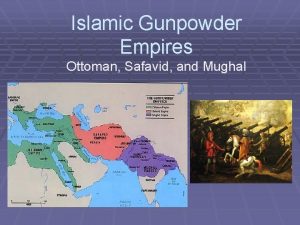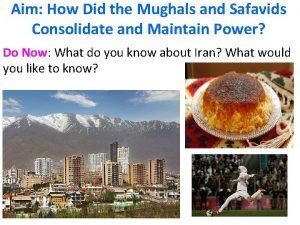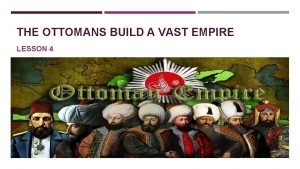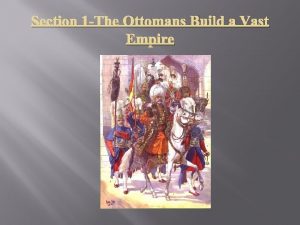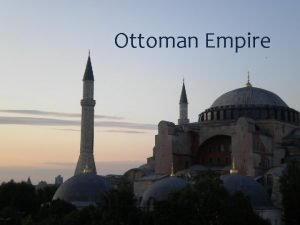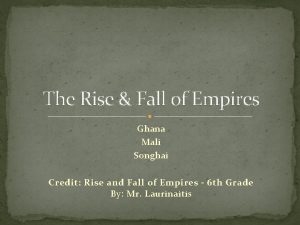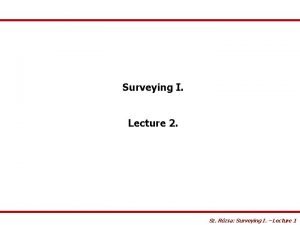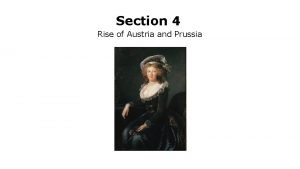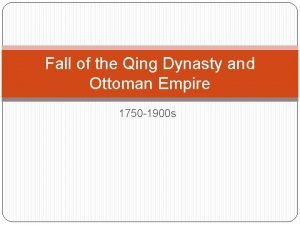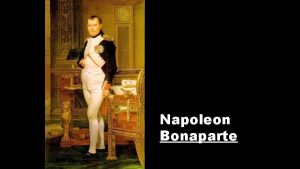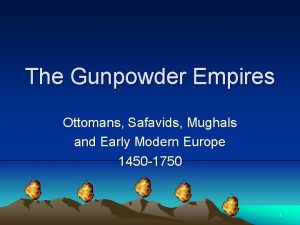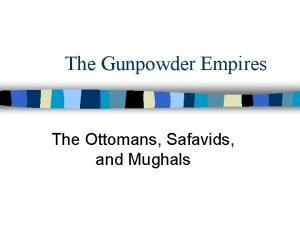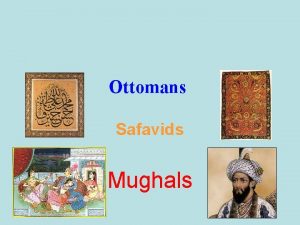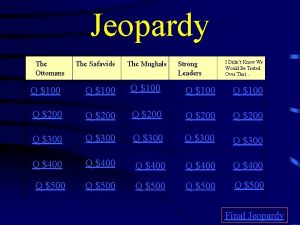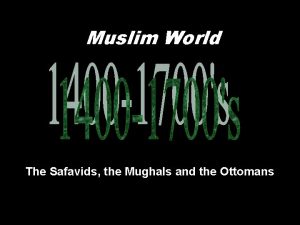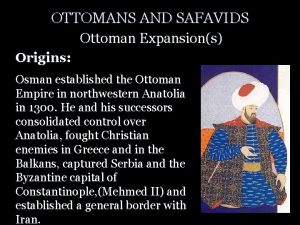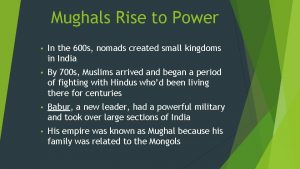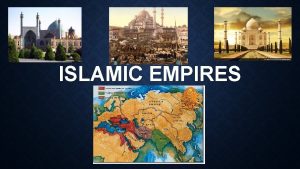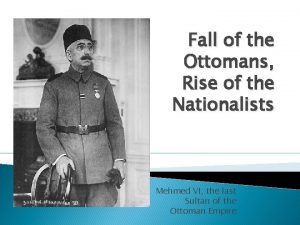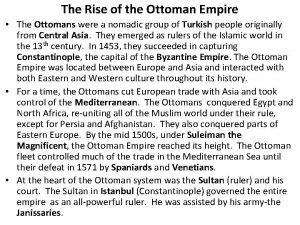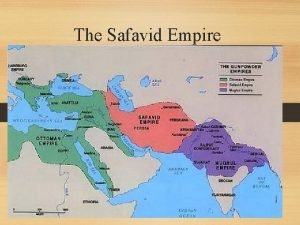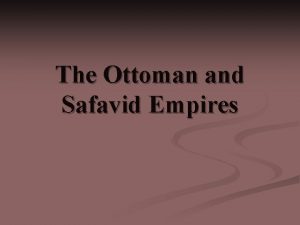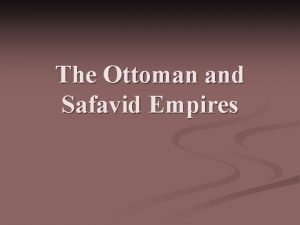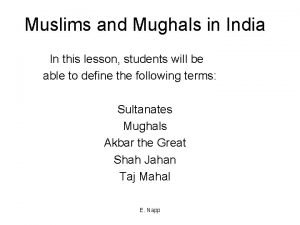The Mughals Ottomans and the Safavids The rise




























- Slides: 28

The Mughals, Ottomans, and the Safavids The rise of the Islamic Empires

Why India? “The whole of India is full of gold and jewels. . . ” “and since the inhabitants are chiefly infidels and idolaters, by the order of God and his Prophet, it is right for us to conquer them. ” -Sultan Mahmud of Ghazni What is the meaning of this quotation?


Sultan Mahmud of Ghazni - leader of the Ghaznavid Empire (modern day Iran, Afghanistan, and Pakistan) - 1001 AD led armies into Northern India (used riches to increase wealth)

Sultan of Ghur - late 1100 s, the sultan of Ghur (Ghurid dynasty/ Eastern Iranian) defeated Hindu armies throughout the northern plain - established a Sultanate in Delhi (land ruled by a sultan) - lasted from 1206 -1526 and symbolized the start of Muslim rule in India (although the region was ruled by different groups)

Why were Muslims successful? - better military technology - central government/leadership - Hindus convert to Muslim

Muslims and Hindus - Hinduism was accepted as a monotheistic religion - paid the “non-Muslim tax” they could practice their religion - Hindus became rajahs or local rulers - Indian merchants attracted to Muslim trade connections

Decline of Delhi 1398 - Tamerlane (leader of Tartars, descendant of Genghis Khan) invaded India and established a short-lived empire - plundered the Northern Indian Plain and slaughtered thousands of Hindus - captured artisans to build capital at Samarkand (city in modern day Uzbekistan) - sultans no longer had control over India - increased tensions between Muslims and Hindus

Babur - Babur the first Mughal Emperor, was a descendent of Genghis Khan and great grandson of Tamerlane - Babur succeeded his father as ruler of Turkestan when he was only 12 (although he was swiftly deposed by older relatives) - Babur moved to Afghanistan in 1504 and gained power then moved on to India - Babur defeated the ruler of India and decided to take over himself

War on the Delhi Sultanate - Babur defeated the ruler of the Delhi Sultanate Ibrahim Lodi in 1526 - Used his well-trained veteran army of 12, 000 to defeat the sultan's force of more than 100, 000 - Babur defeated the Lodi sultan decisively at Panipat (in modern-day Haryana, close to the city of Delhi)

Babur’s Policies Babur captured the Turkic Ghur'iat Sultanate of Delhi in 1526, imposing his rule on most of Northern India. The Empire he founded was a sophisticated civilization based on religious toleration (it was a mixture of Persian, Mongol and Indian culture) Under Babur Hinduism was tolerated and new Hindu temples were built with his permission. Trade with the rest of the Islamic world, especially Persia and through Persia to Europe, was encouraged.

Babur’s India The importance of slavery in the Empire diminished and peace was made with the Hindu kingdoms of Southern India. His first act after conquering Delhi was to forbid the killing of cows because that was offensive to Hindus. Babur may have been descended from brutal conquerors, but he was not a barbarian bent on loot and plunder. Instead he had great ideas about civilization, architecture and administration.

Humayun Babur was followed by his son Humayun who was a bad emperor, a better poet, and he rapidly lost the empire. He did eventually recover the throne but died soon afterwards after breaking his neck falling downstairs.


Akbar The third Emperor, Abu Akbar, is regarded as one of the great rulers of all time Akbar succeeded to the throne at 13, and started to recapture the remaining territory lost from Babur's empire. By the time of his death in 1605 he ruled over most of north, central, and western India.

Akbar the Great 1556 -1605 Born Jalal-ud-Din Akbar, he won important military battles and established alliances extending his territories in India Akbar was able to rule without the interruptions and influences of overbearing ministers and court factions due to his strong leadership skills A "workaholic" who seldom slept more than three hours a night he established a strong government administration that became the backbone of the Mughal Empire

Accomplishments Akbar worked hard to win over the hearts and minds of the Hindu leaders (he married a Hindu princess Jodha Akbar) Believed that all religions should be tolerated and he established a form of delegated government Akbar's government machine included many Hindus in positions of power and responsibility Akbar also ended a tax (jizya) that had been imposed on non-Muslims Non-Muslims were not forced to obey Islamic law

Godism Akbar took the policy of religious toleration even further by breaking with conventional Islam. The Emperor proclaimed an entirely new state religion of 'God -ism' (Din-i-ilahi) - a jumble of Islamic, Hindu, Christian and Buddhist teaching with himself as deity. Fatehpur Sikri was the new capital built by Akbar, as a part of his attempt to absorb other religions into Islam. Fatehpur Sikri is a synthesis of Hindu and Islamic architecture.

Ottoman Empire The Ottoman Empire was the one of the largest and longest lasting Empires in history. It replaced the Byzantine Empire as the major power in the Eastern Mediterranean. The Ottoman Empire reached its height under Suleiman the Magnificent (reigned 1520 -66), when it expanded to cover the Balkans and Hungary, and reached the gates of Vienna. The Empire began to decline after being defeated at the Battle of Lepanto (1571) and losing almost its entire navy (eventually known as the “Sick Man of Europe”)


At its peak it included. . . Turkey Egypt Greece Bulgaria Romania Macedonia Hungary Palestine Jordan Lebanon Syria Parts of Arabia Much of the coastal strip of North Africa

Suleiman The Magnificent or the Lawgiver….

The Magnificent? Suleiman was born on November 6 th 1494 and became 10 th sultan of the Ottoman Empire in 1520 – his father Mohammed II, captured Constantinople in 1453. Suleiman’s empire encompassed three continents and controlled western Asia, eastern Europe, and northern Africa and dominated the surrounding seas. Istanbul, the capital, became one of the largest and wealthiest cities in the world, attracting flocks of diplomats, merchants, and artists, who came to reap its riches. Europeans called Suleiman the Magnificent - Venetian Ambassador, Bernardo Navagero commented : "The Turkish Court is a superb sight, and most superb is the Sultan himself. One's eyes are dazzled by the gleam of gold and jewelry….

The Lawgiver? As sultan of the Ottoman Empire, Suleiman made his supreme rule clear: In all documents, he signed the following: I AM SULEYMAN, SLAVE OF GOD, MASTER OF THE WORLD, PROTECTOR OF MUSLIMS, CHRISTIANS AND JEWS. CAESAR OF ALL THE LANDS OF ROME MY NAME IS READ IN ALL THE PRAYERS IN ALL THE CITIES OF ISLAM SULTAN OF SULTANS IN ALL THE LANDS OF ARABS AND PERSIANS, CONQUEROR OF HUNGARY


The Safavid Empire Founded by Ismail (r. 1501 -1524) - His father, leader of a Shīʿite group known as the Kizilbash (“Red Heads”), died in battle against the Sunnis - Ismāʿīl emerged at the age of 14 to take his father’s position as head of the Kizilbash - He quickly established a base of power in northwestern Iran, and in 1501 he took the city of Tabrīz and proclaimed himself shah

Abbas the Great Shah of Persia from 1588 to 1629 - Strengthened the Ṣafavid dynasty by expelling Ottoman and Uzbek troops from Persian soil and by creating a standing army. - He also made Eṣfahān the capital of Persia and fostered commerce and the arts, so that Persian artistic achievement reached a high point in his reign.

Major Accomplishments Economy - reduced taxes on farmers and herders - encouraged the growth of industry Religion - tolerated non-Muslims and valued economic contributions Arts and Culture - welcomed artists, poets, and scholars to his court at Isfahan Politics - met and mingled with inhabitants and spoke with the people (upon hearing stories of corruption, he punished the guilty)
 Islamic gunpowder empires ottomans safavids and mughals
Islamic gunpowder empires ottomans safavids and mughals How did the safavids consolidate power
How did the safavids consolidate power Richard nixon tricky dicky
Richard nixon tricky dicky Rise and rise again until lambs become lions
Rise and rise again until lambs become lions Rise and rise again until lambs become lions
Rise and rise again until lambs become lions A union b example
A union b example The ottomans build a vast empire
The ottomans build a vast empire The ottomans build a vast empire
The ottomans build a vast empire Where did the ottomans come from
Where did the ottomans come from Where did the ottomans come from
Where did the ottomans come from The periodic daily rise and fall of ocean water
The periodic daily rise and fall of ocean water Imperyong ghana mali at songhai
Imperyong ghana mali at songhai Napoleon assignment
Napoleon assignment Ian watt rise of the novel summary
Ian watt rise of the novel summary Rzsa
Rzsa Rise of austria and prussia
Rise of austria and prussia Othello plot synopsis
Othello plot synopsis Fall of qing dynasty
Fall of qing dynasty Hoc method in survey
Hoc method in survey Area of low pressure where air masses meet and rise
Area of low pressure where air masses meet and rise Spring tide and neap tide
Spring tide and neap tide Graphing speed slope
Graphing speed slope Rome and the rise of christianity
Rome and the rise of christianity Napoleon's rise to power timeline
Napoleon's rise to power timeline Rise and shine primary school
Rise and shine primary school And her children will call her blessed
And her children will call her blessed As of now
As of now 5-1 rate of change and slope form g
5-1 rate of change and slope form g Isaiah 60:1-5
Isaiah 60:1-5
